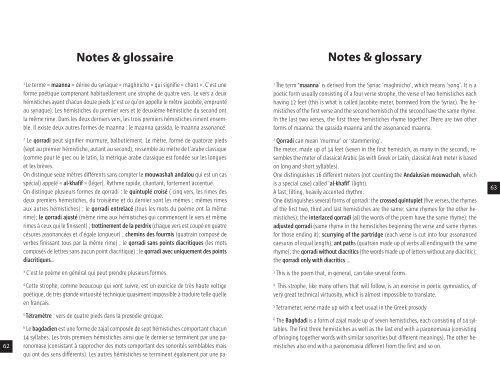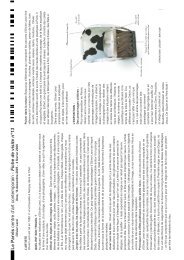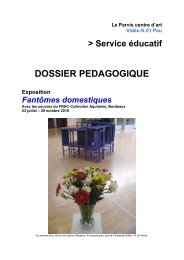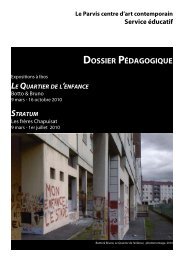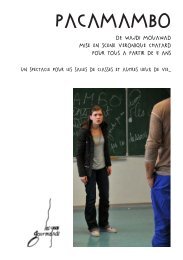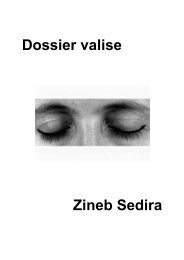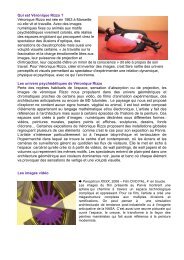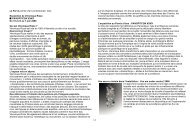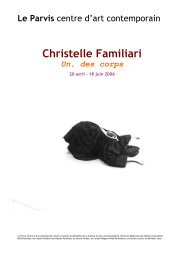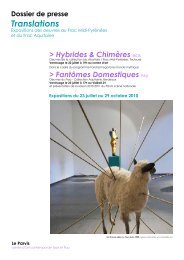You also want an ePaper? Increase the reach of your titles
YUMPU automatically turns print PDFs into web optimized ePapers that Google loves.
62<br />
Notes & glossaire<br />
1 <strong>Le</strong> terme « maanna » dérive du syriaque « maghnicho » qui signifie « chant ». C’est une<br />
forme poétique comprenant habituellement une strophe de quatre vers. <strong>Le</strong> vers a deux<br />
hémistiches ayant chacun douze pieds (c’est ce qu’on appelle le mètre jacobite, emprunté<br />
au syriaque). <strong>Le</strong>s hémistiches du premier vers et le deuxième hémistiche du second ont<br />
la même rime. Dans les deux derniers vers, les trois premiers hémistiches riment ensemble.<br />
Il existe deux autres formes de maanna : le maanna qassida, le maanna assonancé.<br />
2 <strong>Le</strong> qorradi peut signifier murmure, balbutiement. <strong>Le</strong> mètre, formé de quatorze pieds<br />
(sept au premier hémistiche, autant au second), ressemble au mètre de l’arabe classique<br />
(comme pour le grec ou le latin, la métrique arabe classique est fondée sur les longues<br />
et les brèves.<br />
On distingue seize mètres différents sans compter le mouwashah andalou qui est un cas<br />
spécial) appelé « al-khafif » (léger). Rythme rapide, chantant, fortement accentué.<br />
On distingue plusieurs formes de qorradi : le quintuplé croisé ( cinq vers, les rimes des<br />
deux premiers hémistiches, du troisième et du dernier sont les mêmes ; mêmes rimes<br />
aux autres hémistiches) ; le qorradi entrelacé (tous les mots du poème ont la même<br />
rime); le qorradi ajusté (même rime aux hémistiches qui commencent le vers et même<br />
rimes à ceux qui le finissent) ; trottinement de la perdrix (chaque vers est coupé en quatre<br />
césures assonancées et d’égale longueur) ; chemins des fourmis (quatrain composé de<br />
verbes finissant tous par la même rime) ; le qorradi sans points diacritiques (les mots<br />
composés de lettres sans aucun point diacritique) ; le qorradi avec uniquement des points<br />
diacritiques…<br />
3 C’est le poème en général qui peut prendre plusieurs formes.<br />
4 Cette strophe, comme beaucoup qui vont suivre, est un exercice de très haute voltige<br />
poétique, de très grande virtuosité technique quasiment impossible à traduire telle quelle<br />
en français.<br />
5 Tétramètre : vers de quatre pieds dans la prosodie grecque.<br />
6 <strong>Le</strong> bagdadien est une forme de zajal composée de sept hémistiches comportant chacun<br />
14 syllabes. <strong>Le</strong>s trois premiers hémistiches ainsi que le dernier se terminent par une paronomase<br />
(consistant à rapprocher des mots comportant des sonorités semblables mais<br />
qui ont des sens différents). <strong>Le</strong>s autres hémistiches se terminent également par une pa-<br />
Notes & glossary<br />
1 The term ‘maanna’ is derived from the Syriac ‘maghnicho’, which means ‘song’. It is a<br />
poetic form usually consisting of a four-verse strophe, the verse of two hemistiches each<br />
having 12 feet (this is what is called Jacobite meter, borrowed from the Syriac). The hemistiches<br />
of the first verse and the second hemistich of the second have the same rhyme.<br />
In the last two verses, the first three hemistiches rhyme together. There are two other<br />
forms of maanna: the qassida maanna and the assonanced maanna.<br />
2 Qorradi can mean ‘murmur’ or ‘stammering’.<br />
The meter, made up of 14 feet (seven in the first hemistich, as many in the second), resembles<br />
the meter of classical Arabic (as with Greek or Latin, classical Arab meter is based<br />
on long and short syllables).<br />
One distinguishes 16 different meters (not counting the Andalusian mouwachah, which<br />
is a special case) called ‘al-khafif’ (light).<br />
A fast, lilting, heavily accented rhythm.<br />
One distinguishes several forms of qorradi: the crossed quintuplet (five verses, the rhymes<br />
of the first two, third and last hemistiches are the same; same rhymes for the other hemistiches);<br />
the interlaced qorradi (all the words of the poem have the same rhyme); the<br />
adjusted qorradi (same rhyme in the hemistiches beginning the verse and same rhymes<br />
for those ending it); scurrying of the partridge (each verse is cut into four assonanced<br />
caesuras of equal length); ant paths (quatrain made up of verbs all ending with the same<br />
rhyme); the qorradi without diacritics (the words made up of letters without any diacritic);<br />
the qorradi only with diacritics …<br />
3 This is the poem that, in general, can take several forms.<br />
4 This strophe, like many others that will follow, is an exercise in poetic gymnastics, of<br />
very great technical virtuosity, which is almost impossible to translate.<br />
5 Tetrameter, verse made up with 4 feet usual in the Greek prosody<br />
6 The Baghdadi is a form of zajal made up of seven hemistiches, each consisting of 14 syllables.<br />
The first three hemistiches as well as the last end with a paronomasia (consisting<br />
of bringing together words with similar sonorities but different meanings). The other hemistiches<br />
also end with a paronomasia different from the first and so on.<br />
63


